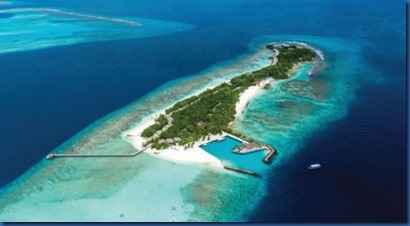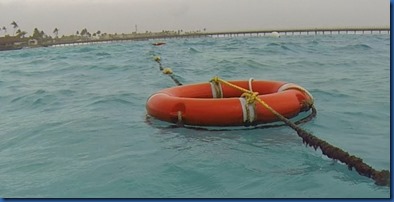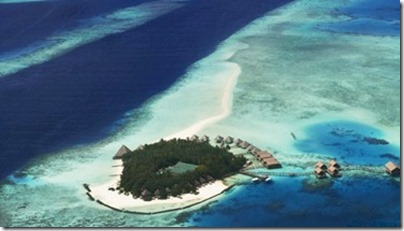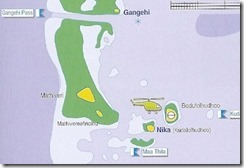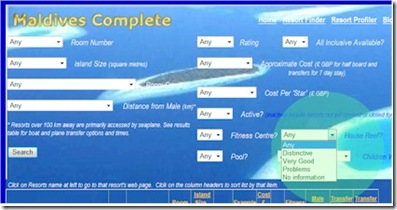I’ve already elaborated on the benefits of a channel house reef with its flow from the open ocean to the inner atoll often providing a highway for big creatures. OBLU by Atmosphere (Helengeli) features TWO channel house reefs as its extended shapes extends from the atoll edge into the inside. It’s rare find due to plateaus taking reefs far from island and making them less accessible.
Best of the Maldives: Snorkel Safety Ring – SAii Lagoon / Hard Rock
One of the appeals of snorkeling and swimming in the Maldives is the mill pond calm waters of the sea stilled by the atoll reef topology. But any body of water, including your bathtub, can be a drowning risk. Not surprisingly, for a country 99% water, the biggest cause of fatality for guests to the country is drowning. Perhaps seduced by the placid feel, people can literally get in over their head. To help reduce the risk of snorkellers getting into trouble (or just to provide a place where they can stop and rest and maybe chat easily with their snorkel buddy), Hard Rock and SAii Lagoon have placed hi-vis floatation rings at the lagoon snorkeling spot (where they have placed a few underwater items to attract fish and provide visual interest in an area which is, and always has been, most sandy shoals.
Best of the Maldives: House Reef Platform – Kandima
One of the key criteria to a great house reef is accessibility. The intra-atoll drop-of-sand islands typically have house reefs a few metres from shore. You don’t have to juggle the logistics of signing up to a resort excursion to take you to some snorkel spot. Instead, you can just dive in and the aquatic wonderland reveals itself to you instantly. It is not just the convenience of proximity, but also a bit of reassurance. Despite the fact that you might be standing metre (on the sand not the coral, please!) in merely a metre of mill pond calm water, there is still something unsettling about swimming hundreds of yards off shore. And snorkeling can take a bit of energy so if you have had a particularly extensive outing, then the last thing you relish is an extended swim back to shore.
The islands that on the outer reef tend to be on broad tables which may make for expansive lagoons, but make for either weak or distant house reefs. Some of the resorts on these islands will typically offer regularly excursions taking people to the edge in a dhoni for an easy splash onto the reef.
Kandima does sit on an outer reef plateau and it has gone a step further to support house reef snorkeling constructing a platform in the lagoon relatively close to the edge. You can use it as a base camp for your house reef expedition. Or just for some middle of the ocean swimming or sun bathing.
Best of the Maldives: House Reef Cave – Amilla Fushi
For those who prefer their resort (wo)man caves underwater, Amilla Fushi’s house reef features a striking cave right on its house reef. The Blue Hole is a popular dive site in the area exits and entries at different depths in three different places. It opens at 5 meters and then has exits at 12 and 21 meters.
Best of the Maldives: Channel House Reef – Gangehi
For many Maldive aficionados, the holy grail of the ideal idyll is a spectacular house reef. Typically, the best house reefs are on the dot-shaped islands in the center of an atoll as the topology on the edges of the atoll lend themselves to long, broad shallow tables which make for great lagoons, but often hard to reach “drops off” (the defining feature of a great house reef).
The Gangehi resort has a very distinctive house reef because its drop off is in a “channel”. Channels exist all over the Maldives and are narrow water passages between the inside and the outside of the atoll. Gangehi’s is named “Gangehi Kandu” which is the Dhivehi word for these waterways.
Bigger fish tend to like the deeper channels, but being intra-atoll, they should be a bit calmer. Certain species tend to favour outside the atoll and other the inside. But this area would seem to have the best of both worlds (Gangehi also has a sheltered side (East) to its house reef to provide more conventional house reef snorkelling). The resort brochure describes…
“Gangehi Island lies on the north-western edge of Ari Atoll, on a oceanic pass, a natural channel crossing the atoll ring that keep in communication the atoll lagoon with the open ocean. The pass, named ‘Kandu’ in Divehi, has a very high ecological function for the Atoll marine life, as it makes possible the renewing lagoon waters. Kandu usually subject to strong currents, incoming or outgoing depending on the tide conditions, and creating a unique environment great for many pelagic species, and a few benthic species cling to the substrates. Gangehi Kandu is one of the longest channels in the Ari Atoll, with a drift of more than 2.5 km from the channel’s entrance to the end of the dive at the inside of the Atoll. The wall here is quite unremarkable really. There are interesting things to spot such as lionfish, moray eels and porcupine fish but the real action is out in the blue. With an incoming current the visibility can be excellent and the parade of pelagic and local residents, impressive. You might see vast schools of fish like fusiliers and blu trigger fish feed in colliding waters, a number of reef sharks as well as barracuda, jackfish and tuna. Large squadrons of eagle rays are frequently seen here seemingly flying in formation in an unforgettable display. The bottom of the entire channel at Gangehi Kandu is sandy, making it a perfect resting ground for Stingrays, White Tip Reef Sharks and the Leopard or Zebra Shark which is commonly spotted here when the conditions are right. At this impressive sites divers can find caves covered with excellent soft coral, a wide range of colourful invertebrates, gorgonians and sponges. The water inside the atoll is breeding ground for plankton and when the outgoing currents bring the plankton-rich water through the channel into the big blue large and beautiful species like manta come to feed.”
Lori and I had the immense pleasure of snorkelling the kandu during our stay there and Lori then went on a drift dive at the edge of the atoll where she saw black sting ray, octopus, eagle rays, a monstrous Napoleon fish (bigger than herself) and many, many sharks especially grey sharks.
That’s the Kandu Spirit!
Best of the Maldives: House Reef Wreck – Chaaya Reef Ellaidhoo
From a snorkel enhancement to a wreck, to a wreck enhancement to a snorkel. The Chaaya Reef Ellaidhoo extensive house includes its own wreck. A small inter-island cargo ship just off the main jetty. Usually such wrecks are the province of dive trips or excursions, but at Ellaidhoo, it’s just another handy feature of their extensively equipped house reef.
House Reefs
“How is the house reef?”
That is one of the most common and critical questions prospective visitors ask when considering a Maldives resort. One of the marquee Maldivian activities, perhaps the best in the world, is snorkelling. And the main event to snorkelling is the ‘house reef’.
When I was first introduced to the Maldives by friend and colleague Andy Lees, his main words of advice were to make sure the resort had a great house reef. Of course, the sun, the sand and the overall paradise can be more than enough for a spectacular holiday for many. Also, those resorts poorly endowed in this all things reefy almost always offer many excursions to take guests to excellent nearby reefs for snorkelling.
I’ve covered the subject of house reefs on several occasions…’Closest House Reef’, ‘Best House Reef’, ‘House Reef Drop Off’.
But the subject has come up so frequently that I have decided to add a ‘House Reef Quality’ parameter to the Maldives Complete database of resorts. The breakdown is fairly basic, but it will provide some general help to people who do want to filter on this variable…
- Distinctive. One of the best house reefs in Maldives in one way or another. Only a handful of these.
- Good / Very Good. Where the lion’s share of house reefs sit. These resorts will deliver great snorkelling experiences characteristic of the Maldives
- Problems. Some sort of significant problem or weakness to the resort’s house reef. Usually, the problem is accessibility, but it could be strong currents, no drop off or something else.
- No information. I haven’t been able to find any details yet on the resort’s house reef.
You can filter on this item (see snapshot of ‘Resort Finder’ page above) and the information is included in the Resort Profiles.
Great House Reefs
One of the first questions a true Maldives aficionado asks of a resort is ‘How good is the House Reef?’
When I first heard the advice to seek out the best house reef, I didn’t even know what a house reef was. We arrived at Laguna Beach (the resort that preceded Velassaru) and spent our days snorkelling around the coral croppings in the sandy lagoon. Then on an excursion to Bolifushi (soon to be Jumeirah Vittaveli), we went ‘over the edge’ and our hearts nearly leapt out of our snorkels. It is a truly dramatic experience to go from a few feet of water to a vast open expanse with a wall peppered with colourful coral and schools of tropical fish.
When I visited Vadoo, I got into a discussion with Assistant GM Alex Kovacs about great house reefs. Alex was proudly and valiantly making the case that Vadoo’s was one of if not ‘the’ best house reef in the Maldives’. My wife and I had to have a go with that kind of endorsement and can attest that it is a thoroughly fine experience. I would call it a first class house reef, but I balked at his claim that it was ‘the best’. I’ve covered ‘house reefs’ before including ‘Best House Reef’ (based on TA research), ‘Best House Reef Drop-Off’, and ‘Closest House Reef’.
He then challenged me, what makes a ‘great house reef’? I had some immediate responses, but it subsequently made me reflect on what it the characteristics really were. I came up with the following proposed list of criteria…
- Drop-off (minimum 20 metre drop off)
- Access (maximum 30 metres from shore to drop off)
- Quantity and diversity of fish (especially ‘Little Five’)
- Quantity and diversity of coral
- Length
- Low current (typically on the ‘inner atoll’ side of the island)
- Warm water (this is a given in the Maldives and many tropical destinations, but not a guarantee at other snorkel spots around the world)

